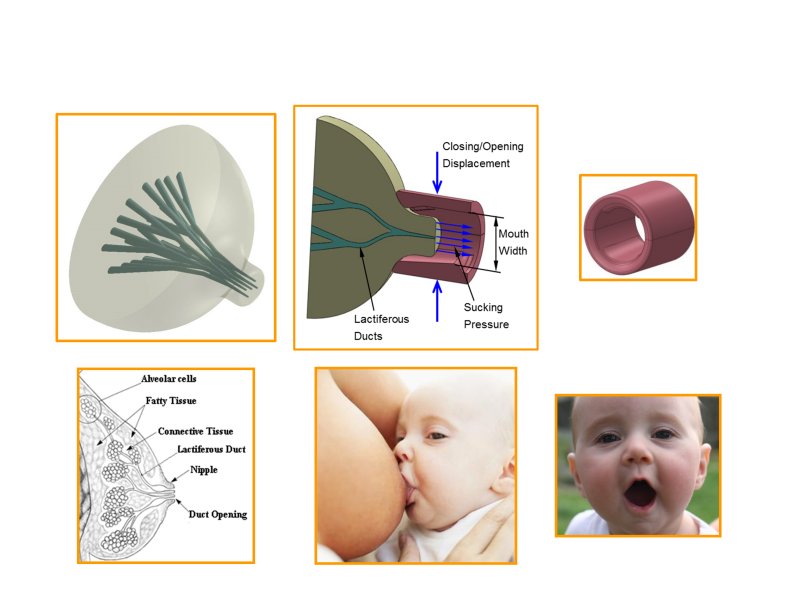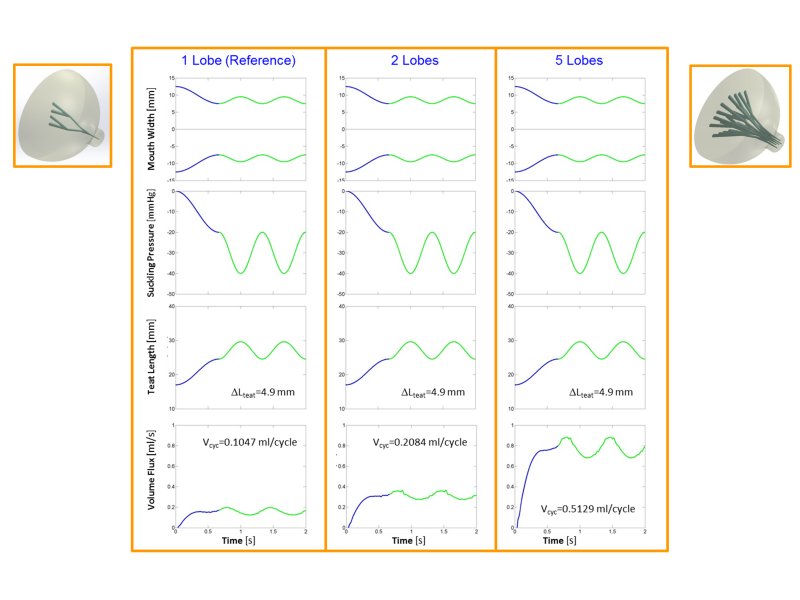Infant Feeding
Bio-physical model of milk extraction during breastfeeding
We developed a 3D computational fluid-structure interaction (FSI) simulation of breastfeeding. The lactating breast was represented by an elastic breast model with an areola and a nipple 12 mm long and a diameter of 15 mm. A complete lobe of branching lactiferous tubes running from the proximal alveoli towards a single outlet in the nipple tip was simulated by a branching network of tubes that end at an outlet of 0.7 mm diameter. The material elasticity of the breast, including nipple and areola, was assumed to behave as a Mooney-Rivlin hyperelastic material with coefficients that fit in vitro force-deformation tests of breast tissue. The infant mouth at maximal opening before starting to latch-on the breast was modeled as an elastic cylinder with inner diameter of 25 mm and length of 30 mm, which was made of 2 halves. The gum was assumed to bulge 1.9 mm from the hard palate. The tongue was assumed to be connected to the lower jaw, while the proximal part of the tongue was 3 mm higher than its distal part. The mouth elasticity allowed partial closure of the mouth due to vertical forces, but its material was much stiffer than that of the nipple/areola. Simulation of the infant feeding on the mother's breast was performed in two stages; first, latch-on the nipple-areola region in order to extend the nipple-areola complex into his oral cavity, followed by periodic suckling maneuvers with his mandible while holding the skull and palate stationary and the mouth sealed on the breast.
Explorations of the physical forces that the infant exerts on the breast to extract milk were performed for a reference breast model with a single lobe of branching lactiferous tubes and suckling rate of 1.5 Hz. For simulation of latch-on we assumed mouth closure from a vertical opening of 25 mm to 15 mm with simultaneous generation of sub-atmospheric sucking pressure of -20 mmHg in the infant mouth (Blue curves). For nutritive suckling we assumed periodic cycles of mouth opening/closing within a range of 5 mm and sub-atmospheric pressure cycling between -20 and -40 mmHg (Green curves). Throughout the simulations we assumed full contact between the mouth model "lips" and the breast areola to ensure mouth sealing as observed during in vivo breastfeeding. The simulation of breastfeeding for the reference case with a single lobe of lactiferous ducts revealed anterior-posterior cyclic displacements of the nipple tip in the range of 4.9 mm and a flow rate of breast milk of 0.105 ml/cycle of suckling. Simulation of the more realistic breast with 5 lobes of branching lactiferous tubes with 5 outlets in the nipple tip yielded the same anterior-posterior motion of the nipple and milk outflow rate of 0.513 ml/cycle. The existing data on the flow rate of milk intake by infants during breastfeeding vary in the range of 0.03 to 0.5 ml/cycle of sucking.





